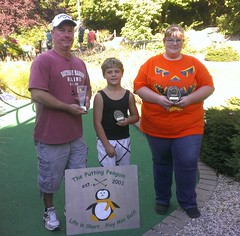What's in a tournament? (Part I)
by Pat Sheridan on 04/16/15
Its T-minus 30 days to US Open and my current preparation status is that I haven't used my putter in over a month. I've also decided airports need to install indoor minigolf courses.
The biggest question I get about miniature golf tournaments is "What goes on at one of those?" In some ways it depends on whether you are talking about a local tournament or a USPMGA tournament. (I won't speak about Putt-Putt/PPA tournaments as I have never played in one and they seem to be a third kind of beast or international competitions since the same inexperience applies. I'm also skipping "charity" tournaments where the focus is solely on raising money for a cause and not the competitive side of the sport).
Since I would highly recommend you playing a local tournament before diving into a USPMGA one, let's start with what you might expect there. My next post will cover the USPMGA details. The great thing about a local tournament is that they come in all shapes and sizes. The bad thing is that variety makes it hard to easily describe what to expect, but I'll do my best to generalize.

The Putting Penguin's Mandy Ranslow playing in a local tournament with Josh Tiberio
Cost and Duration: Most are $10 - $50 to enter. They can be of varying length, with the more expensive being longer, but in general they'll be between one and four rounds of stroke play, with the lowest total score taking home the cash.
Divisions: Most small tournaments don't do multiple divisions or at most they may have a separate kid's tournament. However, some tournaments will do different divisions for different skill levels and they may have different entrance fees and payouts.

2013 Odetah Fall Classic division winners
Purse: A local tournament won't pay much and you may only get a trophy. However, some tournaments will pay up to a couple hundred dollars for first place and pay out through the top four or more places. In the tournament we run, we've always tried to make the purse graduated so 1st place was a large bump over 2nd and 4th place at least won your entrance fee back. But one thing to remember about local tournaments and USPMGA tournaments, you're focus should always be about having fun and enjoying the game and not how much money you win.
Competition: There could be a handful of professionals depending on where the tournament is but a majority of the players will be locals who only play in that tournament each year. While playing against the pros is always tough, the locals present major challenges in these tournaments. They play the course many times during the year and know all of the quirks. Plus they feel comfortable on the greens which gives them confidence to play against the best.
Equipment: You always have the choice of using the course putters and balls but I would suggest not doing that if you can avoid it. The putters can be chipped and uneven and the balls are usually worse for wear. I've never been at a tournament where you can't use your own putter but I have been at a couple where you have to use the course balls. Otherwise you’re allowed to use your own and I favor a Titleist ball, with The Putting Penguin on it, given my familiarity with how it plays and bounces off bricks.
Play: You will generally be grouped in pairs randomly, but some tournaments do threesomes or foursomes, and have a shotgun start (each group starting at a different hole). This ensures everyone finishes rounds at roughly the same time to keep the tournament going. But like everything else, some tournaments will have everyone start on hole 1 and play through a straight 18. Depending on the tournament you might play the whole time with that same group, finishing one round after another, or you may be re-paired after a set of rounds so that folks with similar scores play the final rounds together.
During the actual round, you normally "play through" or "hole out" each hole. This means that instead of letting everyone hit their tee shot and then rotating through the remaining shots, each player plays through the complete hole before the next player goes. This ensures that another player's ball never gets in your way. The rules are set by the course but most often involve space you can pull the ball from the wall (6 inches or a scorecard length in most tournaments), how to handle a ball out of bounds (sometimes a penalty and play from where it went out and sometimes return to your original position without a penalty) and what to do if your ball gets stuck in a tube or obstacle (varies depending on the situation). The rules can sometimes get creative depending on the size and seriousness of the tournament.
You will play honors throughout the round (where the person with the lowest score on the last hole goes first on the next hole) and an important part is that players keep each other's score. This promotes honesty throughout the round plus it ensures that scores get recorded appropriately (you wouldn't believe how easy it is to forgot what you just scored on a hole). At the end of the round, players turn in their scorecard, grab another one and head out for another 18. It's all quite easy!
Next post we'll dive into the differences when playing a USPMGA tournament.

